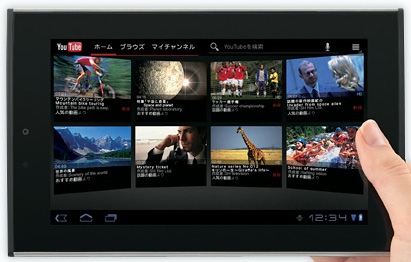Seven-inch Sharp Galapagos tablet runs Android 3.2
Aug 5, 2011 — by Eric Brown — from the LinuxDevices Archive — 1 viewsSharp announced a seven-inch, 1024 x 600-pixel “Galapagos A01SH” tablet running Android 3.2 on an Nvidia Tegra 2 processor — and its FCC approval suggests it's eventually destined for the U.S.. Meanwhile, the Toshiba Thrive “Honeycomb” tablet has received a sleep-and-resume bug fix, and the Samsung Galaxy Tab 10.1 got a “magazine-like” TouchWiz UI update.
Last September, Sharp announced two Android based Galapagos color e-readers in 10.8-inch and 5.5-inch versions. The e-readers hid Android under a Nook-like ebook-focused UI layer. On Aug. 3 in Japan, Sharp and retailer EAccess unveiled a straight-up, general-purpose Android tablet called the Galapagos A01SH, as detailed in an Electronista report.

Galapagos A01SH
Like the seven-inch Huawei MediaPad, the Galapagos A01SH makes use of Android 3.2's optimizations for seven-inch screens. The new Galapagos offers a Samsung Galaxy Tab-like 1024 x 600 resolution, rather than the 800 x 600 pixel touchscreens found on most seven-inch tablets.
Whereas the MediaPad heads off into unchartered waters with a new dual-core 1.2GHz Qualcomm Snapdragon processor, the Galapagos sticks to the well-trampled Honeycomb path, running a similarly dual-core Nvidia Tegra 2 processor. It also ships with 1GB of RAM and 8GB internal memory, according to this translated Galapagos spec page on EAccess.
Other typical Honeycomb features, usually found only on 10.1-inch tablets, include five-megapixel and two-megapixel back- and front-facing cameras, respectively. A microSD slot is available, as well as 802.11n Wi-Fi, Bluetooth 2.1, a micro-USB port, and a headphone output, says EAccess.
The thickness of the device is about average, ranging from 11.9mm to 12.6mm (0.46 to 0.49 inches), and the tablet weighs 389 grams (13.72 ounces), says EAccess. The battery is said to last 7.5 hours under typical use, or six hours with video.
The Galapagos should be available in Japanese stores by the end of the month at a price that EAccess says will be "competitive", according to Electronista. Sharp has promised to eventually bring its Galapagos tablets to the U.S., and the A01SH was said to have passed its FCC certification in late June.
Toshiba Thrive finally wakes up
 The 10.1-inch Toshiba Thrive (pictured at right) shipped last month with Android 3.1, giving buyers confidence they'd encounter fewer of the bugs that plagued early Android 3.0 tablets like the Xoom.
The 10.1-inch Toshiba Thrive (pictured at right) shipped last month with Android 3.1, giving buyers confidence they'd encounter fewer of the bugs that plagued early Android 3.0 tablets like the Xoom.
Yet, many Thrive owners did encounter one nasty bug that forced them to reboot when they tried to wake the device from sleep mode. (For the record, the Clint Boulton review we published July 22 found no such "resume" problems.)
According to several sources, including SlashGear, Toshiba has now released an update that claims to fix the problem while also improving multimedia playback. The update is said to be available via Toshiba's Service Station utility app, which can be found in the Thrive's apps panel.
Samsung Galaxy Tab 10.1 gets TouchWiz update
 A vastly improved TouchWiz UI layer is now available for the Samsung Galaxy Tab 10.1 Android 3.1 tablet (pictured). The UI makeover is available via a hefty 188MB OTA update, according to Engadget.
A vastly improved TouchWiz UI layer is now available for the Samsung Galaxy Tab 10.1 Android 3.1 tablet (pictured). The UI makeover is available via a hefty 188MB OTA update, according to Engadget.
Like many tech publications, Engadget has savaged the TouchWiz UI for years. However, the new tablet-focused version appears to have won some grudging respect from reviewer Brian Heater.

Updated tablet-ready TouchWiz UI layer on Samsung Galaxy Tab 10.1
Source: Engadget
Among other magazine-esque touches, "Swiping right will bring up a large rotating visual newsfeed on the left, offering up headlines laid over news images," writes Heater. A new Mini Mode Tray offers access to commonly use apps, and there is said to be a new "basic photo editor."
The software comes bundled with Samsung Music Hub and Media Hub apps. Engadget calls the latter "an extremely slick entertainment app."
Despite the marked improvement of the new TouchWiz, Heater dings Samsung for essentially blackmailing Galaxy Tab users to use it.
"While Samsung isn't requiring users to accept the skin on their devices, declining it will block you from future OS upgrades — i.e., no Ice Cream Sandwich for you if you don't buy into the world of TouchWiz," writes Heater.
This article was originally published on LinuxDevices.com and has been donated to the open source community by QuinStreet Inc. Please visit LinuxToday.com for up-to-date news and articles about Linux and open source.